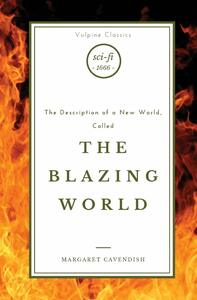Take a photo of a barcode or cover
slow-paced
Plot or Character Driven:
A mix
Strong character development:
Complicated
Loveable characters:
Complicated
Diverse cast of characters:
Complicated
Flaws of characters a main focus:
Complicated
challenging
informative
mysterious
slow-paced
Strong character development:
No
Loveable characters:
Complicated
adventurous
informative
inspiring
reflective
slow-paced
Plot or Character Driven:
N/A
Strong character development:
No
Loveable characters:
No
Diverse cast of characters:
Complicated
Flaws of characters a main focus:
No
adventurous
challenging
informative
mysterious
tense
fast-paced
Plot or Character Driven:
Plot
Strong character development:
Complicated
Loveable characters:
No
Diverse cast of characters:
No
Flaws of characters a main focus:
No
Cavendish is bonkers love her
This collection of Margaret Cavendish' stories caught my attention after reading about pioneers of early science fiction (in other words: women). I purchased this book alongside Jirel of Joiry, which was a prototype for Red Sonja and later I found out, for Dark Agnes. The reason I bring up C.L. Moore's work is because these two novels epitomize two very different approaches towards "feminist" or female lead science-fiction novels. Smith's character is feisty, adamant and hot-tempered and she isn't afraid to fight anything as long as she has her trusty sword. Her adventures vary from trips into a hellish underworld, to tracking down a wizard to outwitting a supernatural deity and his marriage plans. In summary, the character of Jirel was admirable and relatable; she was someone that pursued the good fight, protected the land of Joiry and experienced lost.
The Blazing World, on the other hand, lacked depth and treaded within the realm of a fairytale. This manifests in the choice of leaving the main character without a name except for the titles of Lady and Empress. Initially, I liked this concept but upon reading further into the novel, I felt disconnected from this character. This fact paired with the style of writing caused the story to be tedious. There were many pages, where Empress was conversing with her subjects on philosophical, scientific, metaphysical subjects etc., that I thumbed through. Although interesting, I did not understand the character's motive or even the issue with her current world. What drove her intellectual? What did Empress find disparaging or intriguing about her surroundings? There was no understanding or development of her character that could warrant her actions or desires. (If they even existed)
Upon reaching the section where the Empress began to converse with the Duchess and left her body, was when I lost all hope in the novel. Even the main character herself was dissatisfied with her role in the novel. At this point, I began to conclude that the Empress was an outlet for Cavendish to espouse her views and desires in a time when female expression was restricted. This novel wasn't about developing a world or multi-dimensional characters but a platform to lament on the misfortunes of the author. I do concede that numerous authors have comparably done the same, but it wasn't so obvious and outlandish. This novel, as my fellow readers have said before, lacks a plot, a conflict, and a climax. If Cavendish wanted to complain about her circumstances then why does the world, where the Empress was held "captive", accommodate her needs and desires. (I mean, the emperor let her do whatever she wanted!! What was there to complain about??)
Alas, the character of Empress was disconnected from the narrative and consequently, her story lacked a conflict and climax. Perhaps, this is all due to a misconstrued synopsis on the novel itself, but I was disappointed with this early science fiction.
The Blazing World, on the other hand, lacked depth and treaded within the realm of a fairytale. This manifests in the choice of leaving the main character without a name except for the titles of Lady and Empress. Initially, I liked this concept but upon reading further into the novel, I felt disconnected from this character. This fact paired with the style of writing caused the story to be tedious. There were many pages, where Empress was conversing with her subjects on philosophical, scientific, metaphysical subjects etc., that I thumbed through. Although interesting, I did not understand the character's motive or even the issue with her current world. What drove her intellectual? What did Empress find disparaging or intriguing about her surroundings? There was no understanding or development of her character that could warrant her actions or desires. (If they even existed)
Upon reaching the section where the Empress began to converse with the Duchess and left her body, was when I lost all hope in the novel. Even the main character herself was dissatisfied with her role in the novel. At this point, I began to conclude that the Empress was an outlet for Cavendish to espouse her views and desires in a time when female expression was restricted. This novel wasn't about developing a world or multi-dimensional characters but a platform to lament on the misfortunes of the author. I do concede that numerous authors have comparably done the same, but it wasn't so obvious and outlandish. This novel, as my fellow readers have said before, lacks a plot, a conflict, and a climax. If Cavendish wanted to complain about her circumstances then why does the world, where the Empress was held "captive", accommodate her needs and desires. (I mean, the emperor let her do whatever she wanted!! What was there to complain about??)
Alas, the character of Empress was disconnected from the narrative and consequently, her story lacked a conflict and climax. Perhaps, this is all due to a misconstrued synopsis on the novel itself, but I was disappointed with this early science fiction.
http://nwhyte.livejournal.com/2308871.html[return][return]For all the primacy of Frankenstein, I reckon this must be one of the earliest known sf books by a woman, at least in English. The Duchess of Newcastle was a well-known eccentric of Restoration England - Samuel Pepys has several awestruck entries in his diary about simply wanting to look at her in astonishment, including her visit to the Royal Society - and wrote various pieces including this exploration of politics, science, religion and learning from 1668. [return][return]Her unnamed heroine, kidnapped by sea from her home, is blown by storms to the North Pole and thence to another world which adjoins ours there. The inhabitants immediately make her their Empress, and we then settle down for a hundred pages or so of exposition and world-building, some of it a little satirical, some simply speculative and imaginative (some of it perhaps inspired by her visit to the Royal Society the previous year). The Empress then causes further point-of-view confusion by inviting the Duchess of Newcastle to come visit her on her own planet, and, using otherworldly technology, exterminates all of England's military enemies to ensure that Britain can be Top Nation. [return][return]It's a undisciplined, rollicking, diverting ramble through the mind of one of the era's most interesting personalities, and I'm really surprised that it is not better known - I think I came across it only browsing Wikipedia, though I then found an essay about it in Speculative Fiction 2012 when I was already half way through. I also detect one or two elements which surely Swift must have put directly into Gullver's Travels; he would surely have known and read this.
I don’t often read books from the 1600s, so Margaret Cavendish’s proto-sci-fi works collected in [b:The Blazing World and Other Writings|354620|The Blazing World and Other Writings|Margaret Cavendish|https://i.gr-assets.com/images/S/compressed.photo.goodreads.com/books/1328042370l/354620._SY75_.jpg|51879212] was a unique experience. Seeing past visions of distant futures never fails to fascinate me, for they are typically more telling of the time period in which they are written, more so than anything else.
The titular The Blazing World centers on a woman who slips into an alternate world filled with anthropomorphized animals who occupy this new utopia. All are ruled under the Empress, and with her total rule all are able to live in true harmony. This was purposely written as a hopeful future, which is quite different from most other early sci-fi authors who tended to spin more bleak fears and concerns into twisted tales.
While it is kind of cool to see a female protagonist delve into an envisioned future ruled by a matriarch, Cavendish’s love of absolute sovereign rule is more than a bit heavy-handed and in-your-face (and this is present throughout the entire body of work). After all, it is only a utopia because everyone is falling in line and following orders from someone who inherited their role. Given my own present-day, democratically-minded perspective, this story felt a more so like a bucolic horror, though I doubt that was the author’s intention.
Overall, it was definitely a unique reading experience, so if material like this sounds appealing then feel free to pick up a copy.
The titular The Blazing World centers on a woman who slips into an alternate world filled with anthropomorphized animals who occupy this new utopia. All are ruled under the Empress, and with her total rule all are able to live in true harmony. This was purposely written as a hopeful future, which is quite different from most other early sci-fi authors who tended to spin more bleak fears and concerns into twisted tales.
While it is kind of cool to see a female protagonist delve into an envisioned future ruled by a matriarch, Cavendish’s love of absolute sovereign rule is more than a bit heavy-handed and in-your-face (and this is present throughout the entire body of work). After all, it is only a utopia because everyone is falling in line and following orders from someone who inherited their role. Given my own present-day, democratically-minded perspective, this story felt a more so like a bucolic horror, though I doubt that was the author’s intention.
Overall, it was definitely a unique reading experience, so if material like this sounds appealing then feel free to pick up a copy.
when I tried to read this three years ago, I rated it 3/5.
to be fair, it is such a chaotic narrative... very hard to follow, and so much weird pseudo-scientific 17th c. stuff in there.
but now that I appreciate the context (this is 1666 and novels really did not exist! even for a hundred years after this, novels – in the way we enjoy them now – did not really exist) and allowed myself to sink into it a bit more, I actually found this very interesting.
some fascinating and surprising implications about gender, empire, art, language, fiction, everything!
absolutely would recommend. quite readable for its time.
to be fair, it is such a chaotic narrative... very hard to follow, and so much weird pseudo-scientific 17th c. stuff in there.
but now that I appreciate the context (this is 1666 and novels really did not exist! even for a hundred years after this, novels – in the way we enjoy them now – did not really exist) and allowed myself to sink into it a bit more, I actually found this very interesting.
some fascinating and surprising implications about gender, empire, art, language, fiction, everything!
absolutely would recommend. quite readable for its time.
I’ve noticed most of the more negative reviews regard this book as boring... it’s from the 17th century and, especially part 1 of The Blazing World, is more so a series of questions asked to various experts of this new world.
I really enjoyed this and continue to reflect on little details while I fold laundry. My girlfriend also read this and really loved the world building. I found I enjoyed the “The Blazing World” as a sort of door to our own world- reminding me to ask more questions, especially regarding the natural world. (I ended up reading a lot about moths after one of the Empress’s questions about the presence of blood as a requirement for creatures to be considered living organisms).
The Blazing World is the longest of the stories (about 100 pages) but the other stories are still enjoyable.
As an Aside:
“The Contract” was a fun and quick read compared to “The Blazing World.” Though Cavendish obviously came first, “The Contract” reminded me of a short story by F. Scott Fitzgerald called “The Camel’s Back”, which I found to be pretty hilarious.
I really enjoyed this and continue to reflect on little details while I fold laundry. My girlfriend also read this and really loved the world building. I found I enjoyed the “The Blazing World” as a sort of door to our own world- reminding me to ask more questions, especially regarding the natural world. (I ended up reading a lot about moths after one of the Empress’s questions about the presence of blood as a requirement for creatures to be considered living organisms).
The Blazing World is the longest of the stories (about 100 pages) but the other stories are still enjoyable.
As an Aside:
“The Contract” was a fun and quick read compared to “The Blazing World.” Though Cavendish obviously came first, “The Contract” reminded me of a short story by F. Scott Fitzgerald called “The Camel’s Back”, which I found to be pretty hilarious.







